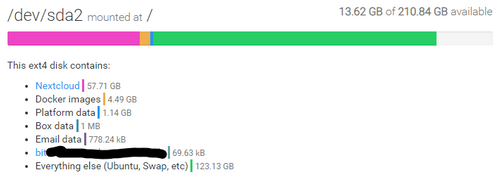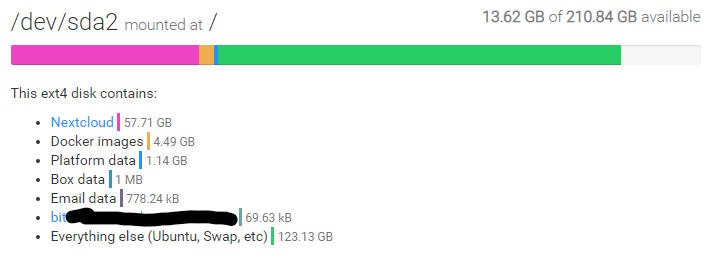Strange storage usage
-
Hi,
as shown in the photo my Cloudron is running out of space. But not from Cloudron or its apps.

I have my Backups on an Nas added via SMB.There is nothing else installed on this VM. As it could only be Cloudron creating 120GB i am not sure how to clean them up.
Once i added 100 GB to the VM and formatted it correctly.Thanks ahead for your help

-
Hi,
as shown in the photo my Cloudron is running out of space. But not from Cloudron or its apps.

I have my Backups on an Nas added via SMB.There is nothing else installed on this VM. As it could only be Cloudron creating 120GB i am not sure how to clean them up.
Once i added 100 GB to the VM and formatted it correctly.Thanks ahead for your help

-
Thanks for the reply.
The Vm has already 5GB of Ram. Swap is about the same of what i can find.I will have a deeper look.
-
@smilebasti Well some of that is the OS, depending on how much RAM you have a lot of that could be swap space, then there is the package cache for apt, etc.
It looks quite normal.
I'd explore using the
ducommand to see what's up. -
@fbartels That's very nice to use. Thanks.
I narrowed it down to /home/yellowtent/appsdata with 53,8 GB but i would not change something here.
The other two huge folders are in /var/lib/docker.
First is /volumes with one large file (53 GB) ending with ...-local-storage. The second (22 GB) is the folder /overlay2.Is it safe to run
docker system prune -a?
Maybe also-volumes? Does this mess anything up with Cloudron if my two apps are running? -
@fbartels That's very nice to use. Thanks.
I narrowed it down to /home/yellowtent/appsdata with 53,8 GB but i would not change something here.
The other two huge folders are in /var/lib/docker.
First is /volumes with one large file (53 GB) ending with ...-local-storage. The second (22 GB) is the folder /overlay2.Is it safe to run
docker system prune -a?
Maybe also-volumes? Does this mess anything up with Cloudron if my two apps are running? -
@smilebasti The
/home/yellowtent/appsdatais the location of apps. This size seems to roughly match the nextcloud size. As for docker, you should not use du tools inside docker's image directories since they are overlays and the du tool is not smart enough to figure out the size correctly. Trydocker system dfto get a better idea about the actual size docker uses (this is what is reported in the graph as ~5GB). The volumes also link into appsdata so they might be double counted the du tools.To take a wild guess, maybe you were backing up to the file system for some time before you moved to NAS via SMB? If this was the case, then you should remove the old backups manually from
/var/backups. You can just safely nuke all the timestamped directories and the snapshot directory inside it.

